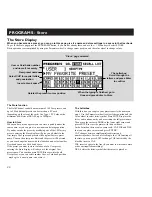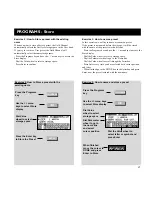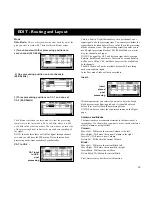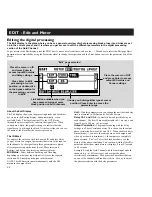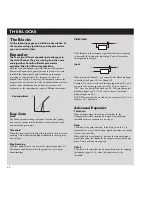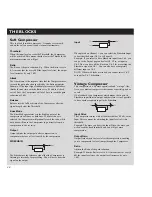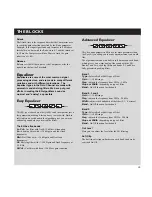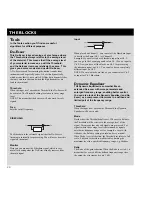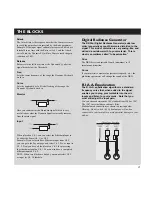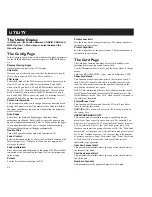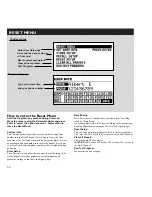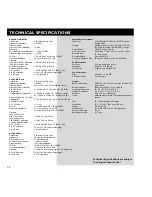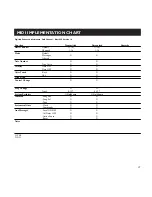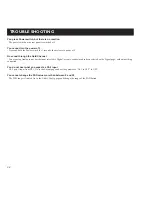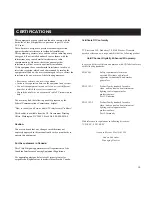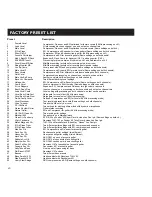
EDIT - Edit and Meter
25
NOTE: The Panner settings of the output also have influence on
the output phase, therefore this Phase Correlation meter is also
shown at the Output page along with the Panner controls.
The OUT Block
The Output block contains M/S matrix, Panners for each channel,
Phase Correlation meter and indication of total processing delay.
M/S Matrix -
Select between Encoding and Decoding,
depending on what you want your output signal to be. Also see
the separate part on M/S recording technique in this manual.
NOTE: This M/S matrix runs simultaneously with the M/S
matrix in the Input block.
Pan Ch.1 and Ch.2 -
These are separate panners for channel
one and channel two, and pan the signal between left and right
outputs.
Output Correlation -
This is a phase correlation meter that
shows you the phase correlation between Ch.1 and Ch.2 outputs.
When the black dot is at maximum (+), you have the same phase
on both outputs and when it goes down to minimum (-), the
outputs are completely phase reversed. The “tail” after the black
dot shows you the history of the phase correlation. You can then,
with the Time/Div. parameter, adjust how much history it
displays: From 0.1 seconds to 0.9 seconds per division.
NOTE: The Delay settings on the input also have influence on
the output phase, therefore this Phase Correlation meter is also
shown at the Input page along with the Delay parameters.
Processing Delay -
Shows you the total amount of delay that
the Gold Channel contributes to the signal due to A-D conversion
and digital processing (1.1 ms minimum). Included is also the
delay settings from the Input block. The figures are read-only
parameters.
If you use the analog outputs, you must add 0.57 ms to the
number shown, because of the time it takes to make the D-A
conversion.
The INSERT block
The Insert block is placed in the routing either pre or post the
processing blocks, and contains parameters to handle send/return
signals and direct channel one and two signals. The idea of the
extended Insert block is to enable a normal send/return insert, but
also to turn the Gold Channel into a four channel mixer, with a
pair of analog inputs, a pair of digital inputs and several output
opportunities.
Send Gain Ch.1 and Ch.2 -
Controls the output gain for the
selected Send output on the Signal page.
Return Ch.1 and Ch.2 -
For the Return channel selected on
the Signal page, you can control the input Gain for each channel
as well as the Panning between Left and Right outputs, and you
also have 340 ms delay available, adjusted in 0.1 ms steps the
first 10 ms and 1 ms steps from 10 to 340 ms.
Direct Ch.1 and Ch.2 -
For the direct signal (main input
source) you have Gain and Panner parameters here for both
channel one and two. These parameters are primarily meant for
the mixer situation. Remember that the Gain must be set to off if
you use it as a normal send/return insert.
NOTE: These two parameters are additional in the signal path,
and do not substitute any of the other gains and panners in the
machine.
Link
The Link option is available whenever you have placed the same
sub-algorithm for example, an advanced EQ - at the same grid
position on each channel. If a Link is possible, a little box will
show up under the blocks. With the cursor you can scroll to the
little box, and with the Value wheel you can activate the Link.
When you activate the Link, the Gold Channel will copy the
settings from channel one to channel two, and any changes you
make will be made on both channels. When you unlink, the
settings will stay as they are, but now you can control each
channel separately again.
NOTE: Link will not be available when you select Ch.2 input
from Ch.1 Post processing.
When a Link is ON, the Sidechain input from Ch.2 to Ch.1 will
not be possible.
Meter Page
The meter page shows you the input of each block in the
Routing. Press Enter or double click on the Bypass buttons, this
will take you to the parameter pages.
Summary of Contents for Gold Channel
Page 1: ...USERS MANUAL Gold Channel DIGITALLY ENHANCED MIC PREAMP...
Page 2: ......










